Numerical investigation on flow and heat transfer characteristics of supercritical RP-3 in inclined pipe
2019-09-28ZhiTAOLingweiLIJinqinZHUXizhuoHULongyunWANGLuQIU
Zhi TAO, Lingwei LI, Jinqin ZHU,*, Xizhuo HU,b, Longyun WANG,Lu QIU
a National Key Laboratory of Science and Technology on Aero-engine Aero-thermodynamics, School of Energy and Power Engineering, Beihang University, Beijing 100083, China
b College of Aeronautical Engineering, Civil Aviation University of China, Tianjin 300300, China
KEYWORDS
Abstract Numerical simulations of flow and heat transfer to supercritical RP-3 through the inclined tubes have been performed using LS k-ε model embedded in Fluent. The physical properties of RP-3 were obtained using the generalized corresponding state laws based on the fourcomponent surrogate model. Mass flow rate is 0.3 g/s, system pressure is 3 MPa, inlet temperature is 373 K. Inclination of the inclined pipe varied from -90° to 90°, with heat flux varied from 300 kW/m2 to 400 kW/m2. Comparison between the calculated result and the experimental data indicates the range of error reasonable. The results of ±45° show that temperature inhomogeneity in inclined pipe produce the secondary flow in its cross section due to the buoyancy force.Depending on the strength of the temperature inhomogeneity, there will be two different forms of secondary flow and both contribute to the convective heat transfer in the pipe. The secondary flow intensity decreases when the inhomogeneity alleviates and thermal acceleration will play a leading role.It will have a greater impact on the turbulent flow to affect the convective heat transfer in the pipe. When changing the inclination, it affects the magnitude of the buoyant component in flow direction. The angle increases, the buoyancy component decreases. And the peak temperature of wall dominated by the secondary flow will move forward and increase in height.
1. Introduction
As the core component of hypersonic vehicles, scramjet engine1-3has attracted great attention among many countries.Considering the impact of air viscosity and stagnation shock it will face sever challenge of thermal management.Regenerative cooling4-8technology has been proposed as an advantageous solution.Nonetheless,the hydrocarbon fuels in the system will flow under supercritical pressure and in supercritical phase finally.
Aiming at the flow and heat transfer characteristics under supercritical phase, some researches have been done to study its mechanism and regularity.9-19Zhou et al.9researched the heat transfer characteristics of pentane under supercritical phase.The relations among the inlet temperature,wall temperature, mass flux, heat flux, system pressure and axis fluid temperature have been obtained. The results show that when the fluid temperature is closed to the pseudo-critical point, heat transfer deterioration occurs. The decrease of heat flux, the increase of mass flux and system pressure will defer the occurrence of heat transfer deterioration. Liu et al.12studied the heat transfer characteristics of n-decane in 0.95 mm and 2 mm tubes under different pressure, heat flux and flow direction using experimental method. It is found that under high Reynolds number the buoyancy force and thermal acceleration affect the heat transfer slightly.While Reynolds number is low and the fluid flows upward, the buoyancy force weakens the heat transfer. Wang et al.15focused on the mechanism of the heat transfer deterioration and found that the dramatic change of properties takes mainly response to it.Specifically under circumstance of low enthalpy the thermal acceleration will be the main reason while under circumstance of high enthalpy the wave of speed in radial direction will be the main reason.
The researches mentioned above are all based on the vertical or horizontal tubes.There are few conclusions about supercritical fluid flowing in the inclined tubes. Wu et al.20studied the heat transfer characteristics of supercritical water in a 22° inclined tube. The result shows buoyancy force will give rise to the natural convection which illustrates the higher temperature at the top of tube wall. Similarly Taklifi et al.21studied the pressure drop characteristic of supercritical water in a 20°inclined tube.It is found that mass flux has a more obvious effect than the heat flux. When the ratio of mass flux to heat flux is larger than 2.46 kg/kWs,heat transfer deterioration will occur near the pseudo-critical point.
Considering that the aircrafts will fly under various postures, generative cooling system must work under conditions inclined.So it is meaningful to study the flow and heat transfer characteristics of supercritical hydrocarbon fuels in inclined tubes. The numerical method has been adopted to study the flow and heat transfer characteristics of supercritical RP-3 in a 1.8 mm inclined tube. It will provide a reference for the design of regenerative cooling system.
2. Methodology
Computational fluid dynamic software ANSYS FLUENT 15.0 is used for the numerical simulation of supercritical RP-3 in inclined tubes. RP-3 thermal physical properties, governing equation, turbulence modelling, computational grid and numerical method are introduced respectively below.
2.1. RP-3 thermal physical properties
China’s aviation kerosene RP-3 is a kind of complex alkane mixture,including hundreds of olefins and aromatic hydrocarbons,etc.In order to obtain the properties of RP-3,it is impossible to model each component of RP-3 in the case of limited computing capacity and memory. And if the base data of properties are dependent on experiments, the workload will be too huge to cover. So the concept of substitution model which substitutes the RP-3 with the mixture of a few typical components has been proposed.Based on the previous studies,a four-species substitution model proposed by Zheng et al.,22consisting of 19.1% n-decane, 36.5% n-dodecane, 29.9% nbutylbenzene and 14.5% methyl-cyclohexane, fits fairly well with the experimental data. The thermodynamic properties and transport properties of the substitution model at different temperatures were obtained by using the generalized corresponding law.The accuracy of it was investigated by the experiments performed in Beihang University.23Therefore,the fourspecies substitution model is selected and the property library is calculated from it. Temperature inhomogeneity results in non-uniformity of physical properties. So the physical properties of RP-3 on a section can be defined as the section integral of physical parameters.
2.2. Physical modelling
The stainless steel tubes have served as the physical model.As can be observed in Fig.1(a),there is a total length of 450 mm,a diameter of 2 mm and a wall thickness of 0.2 mm.In order to eliminate the impact of inlet and outlet effect, the adiabatic section length of 90 mm in the inlet and length of 60 mm in the outlet have been set to ensure the full development of turbulence.The inlet wall is a fixed mass flow boundary and mass flow rate is 0.3 g/s.The outlet wall is a fixed pressure boundary and pressure is 3 MPa.Inlet temperature is 373 K and inclination of the inclined pipe varied from-90°to 90°,with heat flux varied from 300 kW/m2to 400 kW/m2. As can be observed in Fig.1(b),the inclination is the angle between the tube and the horizontal line. It distributes over -90° to 90°.

Fig. 1 Physical model.
According to the characteristics of the physical model, it is divided into one solid region and one fluid region. The grids height of the first layer has been set as 0.0005 mm to satisfy the requirement of LS low Reynolds model that y+<1.The growth rate of the grid height near wall has been set as 1.05.The outlet temperature and convective heat transfer coefficient are selected as the indicators for grid independent solution. The results are shown in Fig. 2.It can be seen that when the number of grids reaches 462,420,the change of two indicators (wall temperature T and heat transfer coefficient h) is less than 1%, which satisfies the condition of grid independent solution.

Fig. 2 Grid independent solution.
2.3. Governing equation and turbulence modelling
Since only the steady flow with uniform heat flux under supercritical pressure is considered in this paper,none of the governing equations contain unstable terms.The governing equations are as follows:
Continuity equation:

where ρ is the density, uiis the velocity tensor and xiis the coordinate tensor.
Momentum conservation equation:

In which

Energy conservation equation:

where turbulence heat flux is modeled by the Boussinesq hypothesis,Pris the turbulent Prandtl number,λ is the thermal conductivity, T is the temperature, ˙Q is the internal heat source, is the dissipation function, H is the specific enthalpy,φ is internal heat source.
Low Reynolds number two-equation model has been selected as the turbulence model. According to previous studies, it can simulate the turbulent flow and heat transfer of supercritical hydrocarbon fuel well.4
Basic equation of k-ε:

where Cμis the constant,fμis the damping function,ε is the turbulent kinetic energy dissipation rate.
Turbulent kinetic energy equation:
Turbulent dissipation rate:

where σεis the turbulent kinetic energy dissipation rate, Cε1and Cε2are the constants, f1and f2are the coefficient functions,Sεis the source term of the turbulent kinetic energy dissipation rate equation.
2.4. Numerical method
The inlet boundary condition is set as the mass flow inlet, the outlet is set as the pressure outlet,the wall of heating section is set as the uniform heating wall with constant heat flux,the wall of inlet and outlet section is set as the adiabatic wall. The pressure-based segregated algorithm has been used to discretize the equations and the simple scheme is adopted as the pressure-velocity coupling method. The second-order upwind scheme is adopted for solving the momentum equation and the energy equation to improve the computational accuracy.The first-order upwind scheme is adopted for solving the turbulence equation to enhance the robustness. The convergence criterion for all equations is that the residual is less than 10-6.
3. Results and discussion
3.1. Calculation method verification

Fig. 3 Comparison of numerical and experimental data.
In order to verify the accuracy of the numerical simulation method, the numerical results are compared with the experimental data. Experimental data from the public paper24has been adopted. The conditions of the data cover the wall heat flux of 300,400 kW/m2at pressure of 5 MPa,inlet temperature of 373 K and mass flow rate of 0.003 kg/s. The comparison is presented in Fig.3.x is where the fluid is located and d is tube diameter.As can be observed that the calculation results are in good agreement with the experimental results in the most region. At x/d=20-60 heat transfer deterioration occurs and the precision of substitution model and turbulence model decrease. The deviation grows a bit.
3.2. Heat transfer characteristics of supercritical RP-3 in 45°tube
In order to study the typical convective heat transfer characteristics of the supercritical RP-3 in the inclined tubes, the reference operating condition at 45°has been selected and in which the mass flow rate is 0.3 g/s, the heat flux is 300 kW/m2, the system pressure is 3 MPa, the inlet temperature is 373 K. A control group without considering buoyancy effect has been set.
As the paper focuses on the influence of dramatic changes in properties and buoyancy force on heat transfer, the effect of cracking will be neglected, for that the temperature region where cracking is remarkable is far away from the pseudocritical point where neither properties nor buoyancy force will affect. The heat transfer coefficient along the tube is in Fig. 4.It is obvious that the heat transfer coefficient without G is lower than the condition with G.Thus the special heat transfer law in inclined tubes can be mainly related to the effect of buoyancy force.Considering the condition with G at 45°,there will be a higher heat transfer coefficient level along entire tube and a peak of it in x/d=20-50.
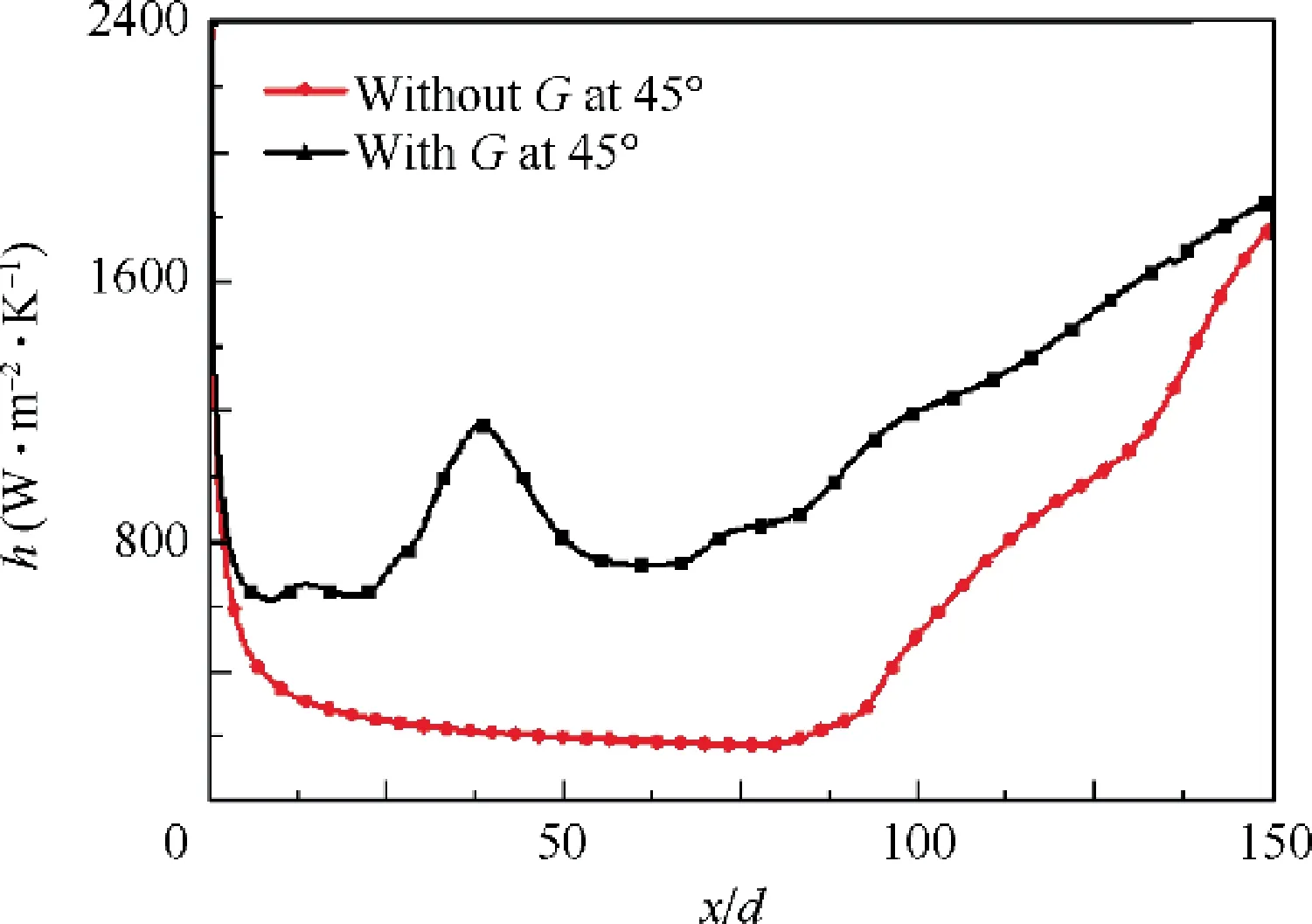
Fig. 4 Heat transfer coefficient distribution along pipe.
Fig. 5 shows the distribution of the fluid section temperature and the secondary flow in cross-sections. In x/d=10 it can be seen that near the wall fluid temperature rise rapidly and enter into the supercritical state soon. Its density is about 100 kg/m3, while the density of the internal fluid in subcritical state is about 700 kg/m3. Between the internal and external fluid a great difference in density exists. Under the effect of the buoyance force,the low density fluid near wall moves from the bottom to the top of the pipe,and the internal fluid moves to the bottom. A pair of vortices in cross section generated.They have two effects.One is that high-temperature fluid near wall will be brought to the vertex and results in the highest temperature at the cross-section. The other is that the lowtemperature fluid at the axis will be brought to the wall which enhances the convection in the cross section. Therefore, the secondary flow caused by the buoyancy force will strengthen the heat transfer of supercritical RP-3 in inclined tubes. As long as there is density deviation and buoyancy force in cross-section of pipe, secondary flow will be induced to enhance the convective heat transfer.So along the whole pipe,the heat transfer coefficient in inclined pipe is higher than that in vertical pipe.And near the outlet, fluid enters the supercritical state, the density deviation disappears. The deviation of heat transfer coefficient disappears too.

Fig. 5 Fluid section temperature and secondary flow distribution in the cross sections in 45°.
Fig. 6 shows the distribution of Re and Gr number in the tube. Re number characterizes the effect of forced convection on fluid flow and heat transfer and Gr number characterizes the effect of natural convection on flow and heat transfer. It can be seen from the figure that the Reynolds number increases along the tube and the Reynolds number does not change substantially in the range of x/d <60. Considering that only the fluid near the wall is heated in the section,the thermal acceleration effect acts on the fluid near the wall surface and impact of the overall flow is small.In the front part of the heating section, the main influence on the flow heat transfer is the secondary flow caused by the floating force and the influence of the floating force is weakened at the rear of the tube. Fig. 6 also indicates that Gr number first increases to the peak then decreases and takes the maximum value around x/d=85.When fluid bulk temperature exceeds the quasi-critical temperature,the density tends to be constant due to the RP-3 characteristics, so the thermal acceleration effect disappears and the Gr number decreases at the end of the pipe.
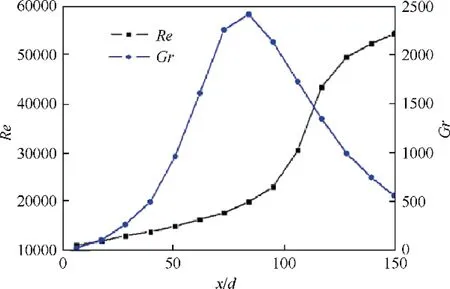
Fig. 6 Re and Gr number distribution along pipe.
In cross-section of x/d=30 secondary flow characteristic changes. Comparing to x/d=15, the other new pair vortices appear at the top of tube. In the front of tube, plenty of hightemperature fluid gathers at the top and block the way of directly moving downward along the center line. The secondary flow has to move toward two sides in cross section as shown in Fig. 5 and the other new pair vortices appear. It is beneficial for the convection in the upper section. The lowtemperature fluid between the wall and internal fluid will disappear and blend quickly. The heat transfer coefficient increases.
The secondary flow refers to the velocity perpendicular to the flow direction of the cross section, the so-called vortex.In fluid mechanics, the vorticity is used to describe this rotational motion and defined as follows:

Ω is vorticity indicating the rotation of fluid velocity vector which expressed with V and ω is the helf of the vorticity. The vector of vorticity has the components in directions of xyz. In this paper,the vortex which expressed with Ωzin the cross section is the main research project.And the direction of vorticity is perpendicular from the plane of vortex.Therefore,the component of vorticity in flow direction has been selected.It is calculated as follows:

The description of vortex strength has been known as eddy flux. For a micro-eddy scroll, the product of the vorticity and the current area is the vortex flux corresponding to the microeddy.Therefore the eddy flux for a finite area which expressed with J can be achieved by the area integral method,as follows,A is the area of the integreation plane:

Quantitative analysis of vortex is important for evaluating the buoyancy effect of supercritical RP-3 under condition of inclination. Vortex flux can directly represent the strength of the vortex.Nevertheless,this parameter can’t be used directly,the Fig.5 illustrates that there will be one or two pairs of symmetrical vortex in the cross-section.Due to the symmetry phenomenon, area integral result of vortex with the opposite rotation direction and same size will be zero.The literature25,26found that it is possible to integrate the vorticity by using absolute values to avoid the problem of symmetry offset.The absolute vortex flux calculation method is as follows:



In above formula, Se represents the dimensionless secondary flow strength. dhis the reference length and the pipe diameter is usually selected. Usrepresents the intensity of the secondary flow. It can be found that the form of Se is similar to Re. Se represents the ratio of inertial force to viscous force in secondary flow that emerges in flow. Dimensionless parameter Se provides quantitative assessing of the secondary flow effect, which is of great significance for more clearly distinguishing its influence on supercritical RP-3 heat transfer.
Fig. 7 shows the distribution of Se calculated from above formula along the pipe at 45°. It can be seen from the figure that the distribution law of Se basically agrees with the distribution law of wall temperature. At the entrance in x/d=0-20, the secondary flow appears, which enhances the heat transfer in the pipe. The temperature uniformity of the fluid is improved and the secondary flow decreases correspondingly. Se starts to rise dramatically at x/d=20 and reaches its maximum at x/d=40 where the heat transfer coefficient reaches its peak too. From above analysis, it shows that at this period there appears a new pair of vortices in the cross section, which greatly enhances the intensity of secondary flow. Furthermore, Se keeps descending and tends to be zero. The Se number represents the intensity of the secondary flow in the section. When the fluid enters the pipeline, the temperature of the fluid that is next to the heated wall rises rapidly, which is prone to approach the supercritical state. If the supercritical state is reached, the density of the flow adjacent to the wall is smaller compared to the low temperature fluid in the middle channel. In the current case, the aforementioned state is reached at the location x/d=50, where the Se number reaches the peak value, indicating that a strong secondary flow is generated in the cross section, which significantly affects the heat transfer. A stronger secondary flow results in a higher heat transfer, which gives a higher Nu and a lower wall temperature under the iso-flux thermal boundary condition.
The secondary flow plays a significant role in the convective heat transfer of inclined pipe.However,as the convection heat transfer is strengthened by the secondary flow, the fluid temperature in tube homogenizes quickly. The difference of density between internal and external fluid decreases. It can be seen in Fig. 7 that Se starts to decrease when x/d >70 and the effect of buoyant force weakens.

Fig. 7 Se number distribution along pipe.
3.3. Heat transfer characteristics of supercritical RP-3 in -45°tube
The study of inclined pipes should cover all the inclinations.It can be mainly divided into up-flow and down-flow conditions.From the perspective of physical model,the main difference is the direction of the gravitational force component in the flow direction and analysis on the effect of gravity force component on flow and heat transfer process. Before conducting comprehensive research of the downward slope conditions, the more specific case -45° for mechanistic research has been selected to obtain the basic mechanism of the special heat transfer law.27-31
Fig.8 shows the temperature distribution inside the inclined tube at -45°. It can be seen from the figure that the temperature distribution law in the downward inclined tube is simpler than that in the upper inclined tube. During the entire flow,only one peak of wall temperature occurs in the middle of the tube, followed by a dip in temperature and eventually a steady rise.

Fig. 8 Wall and axis temperature distribution along the pipe.
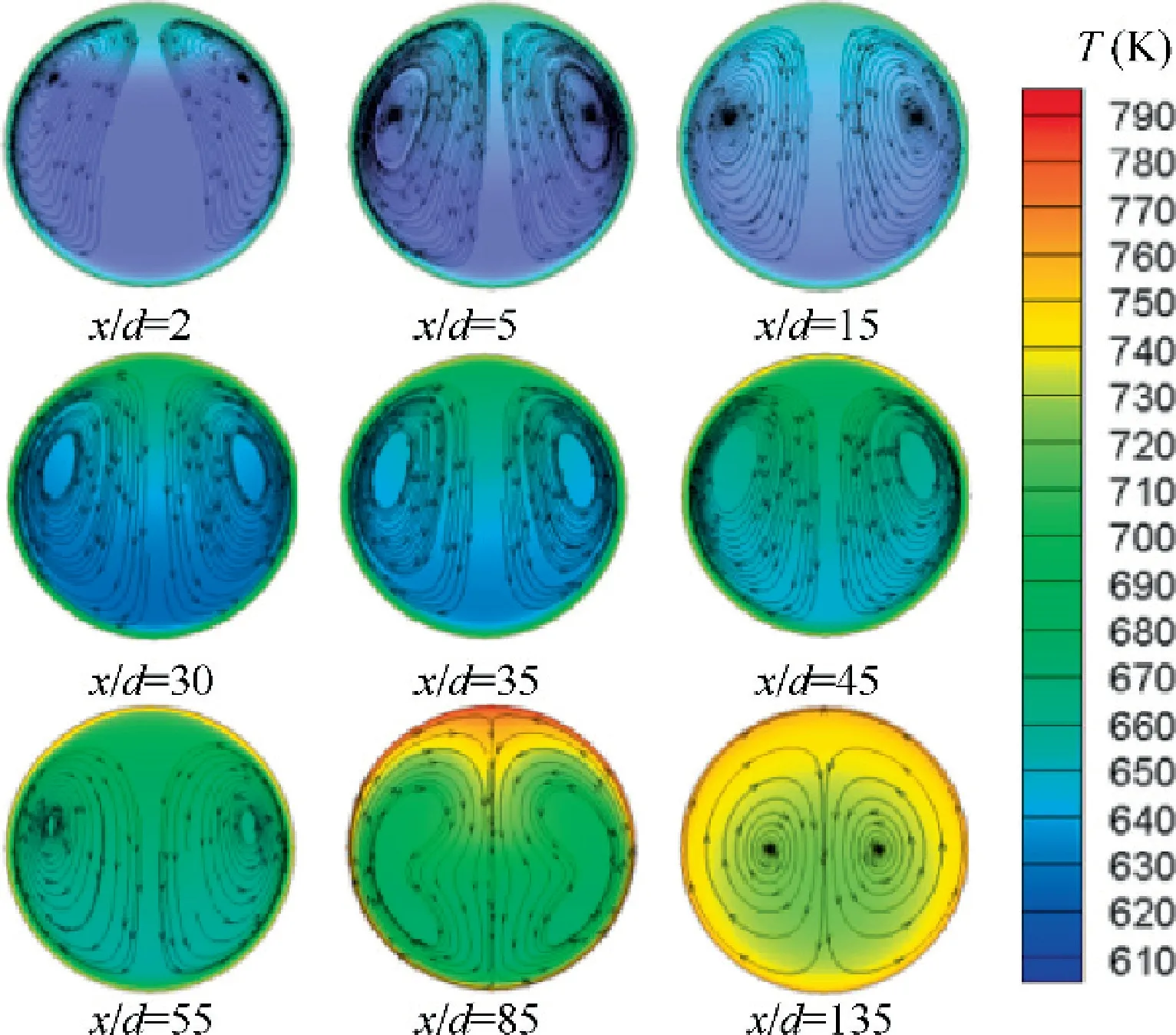
Fig. 9 Fluid section temperature and secondary flow distribution in cross sections in -45°.
Fig. 9 shows the distribution of fluid section temperature and secondary flow in each section along the pipe. As can be seen from Fig. 9, in the previous stage of the curves, the rise in fluid bulk temperature is similar to the 45° condition, starts with the top wall, and gradually extends to the bottom wall.The overall performance shows the high temperature in the top part and the low temperature in the bottom part. In the vicinity of the center line, the hot fluid intrusion is deeper.The biggest difference between 45° and -45° conditions is the degree of intrusion of the central hot fluid. In contrast,Fig. 5 shows that the high temperature fluid at 45° condition rapidly intrudes into the interior under the effect of secondary flow and forms the second pair of vortexes.The whole process is rapid and leads to the fluid bulk temperature uniformity. In the condition of -45°, the fluid temperature near the central line is also higher, but the overall trend of high-temperature fluid diffusion downward is gentler.The secondary flow distribution can be seen in Fig. 9 too. Throughout the entire process, the cross-section secondary flow is symmetrical in the center line, and vortex center position remains essentially stable.Therefore,in the wall temperature distribution,the pipe under the condition of-45°maintains a steady rise in the segment of x/d <60 and keeps a uniform rise in the entire cross section. The reason for this phenomenon is the effect of the buoyancy force in the flow direction. The difference between 45°and-45°conditions lies in the opposite effect of the buoyancy force in the flow direction.As what can be seen from the previous studies,when the buoyancy force direction is opposite to flow direction, the convective heat transfer will be weakened. Therefore, in 45° condition, the wall temperature increases faster and the temperature difference between inside and outside is larger, which leads to obvious secondary flow.For the -45° condition, when the buoyancy force direction is same with flow direction,it will promote the convective heat transfer.Slowly the temperature of fluid near wall rises and the fluid temperature inside will be uniformed under the turbulence effect. The temperature deviation will be smaller. In the same buoyancy force in the cross section, the effect of secondary flow will be weak. Fig. 10 shows Se number distribution along the pipe in -45°. Se indicates the intensity of the secondary flow, which increases slowly at x/d=20-80 and starts to rise sharply at x/d=80, reaches a maximum at x/d=115, enhancing heat transfer in the pipe. So the temperature uniformity of the fluid is improved and the heat transfer coefficient takes the maximum value at x/d=115.
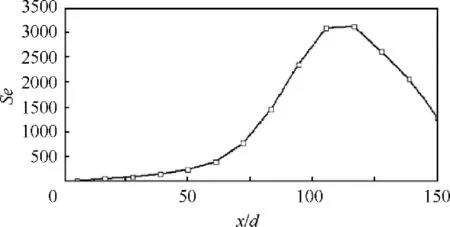
Fig. 10 Se number distribution along the pipe in -45°.
In order to determine the main influencing factors of the heat transfer law in each part along the-45°pipe,the working condition only considering the gravity in flow direction has been calculated. The influence of secondary flow or thermal acceleration on the heat transfer under this condition can be judged. As can be seen from Fig. 11, at the entrance of experimental section, there is a clear peak of sudden temperature rise in the absence of the secondary flow.So the entrance is still the place where the secondary flow is most strongly affected.At x/d=20-80, both of two maintained a steady rise.Although the secondary flow still exists in this position, due to the temperature distribution in the cross section is relatively uniform and the secondary flow is gentle, the influence on the wall temperature is limited. In the case of merely considering gravity in flow direction, the peak of wall temperature still appears at x/d=80-100. Therefore, it can be inferred that the peak is due to other factors such as drastic physical property change and thermal acceleration effect besides the secondary flow.
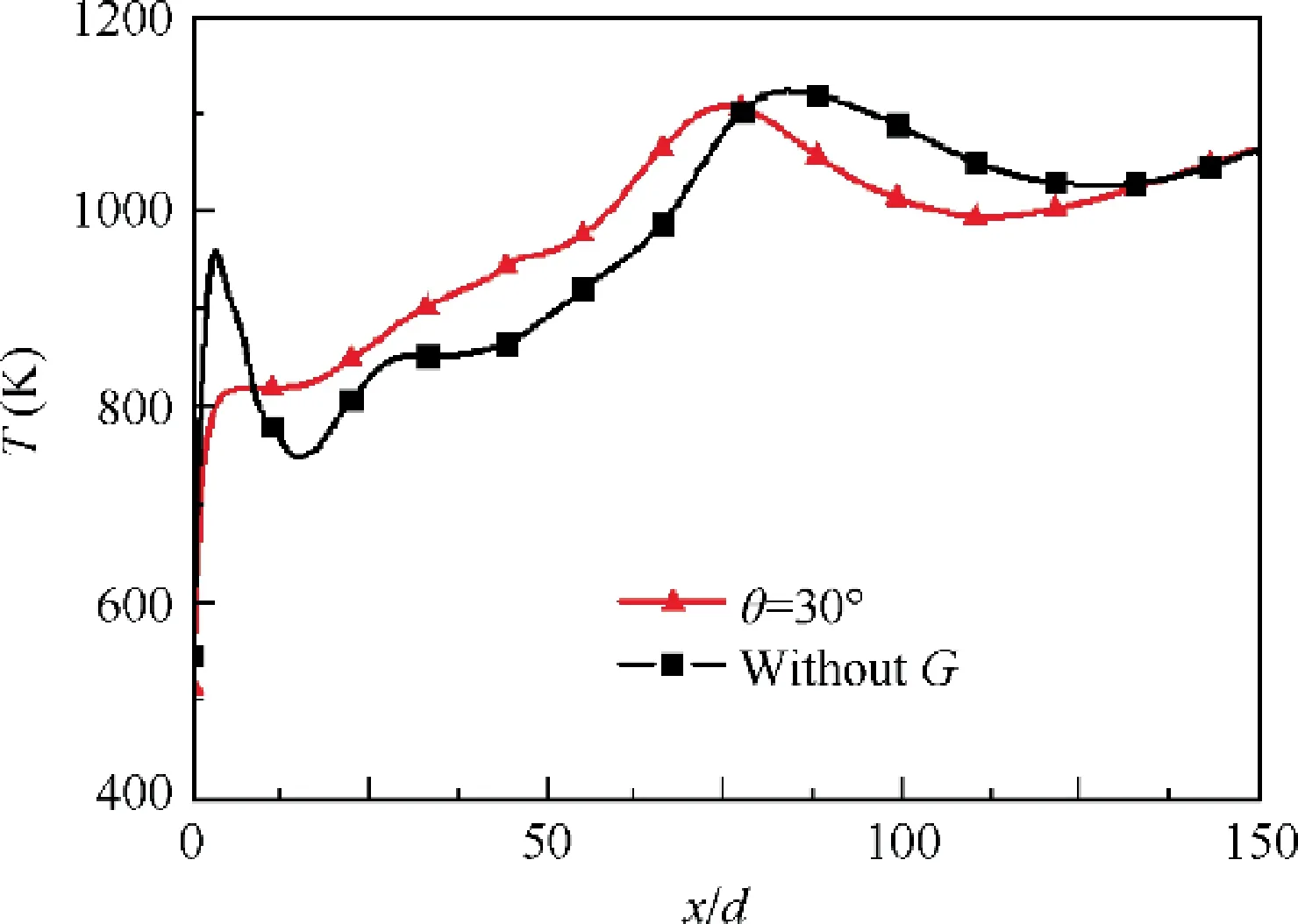
Fig.11 Comparison between inclination which expressed with θ of 30° and condition without G in section.
Fig.12 intercepts the temperature distribution of each cross section in x/d=70-100. It can be seen that the temperature distribution in the -45° pipe is characterized by a marvelous temperature difference between top and bottom of the pipe.The top of the pipe is uniformly heated and the temperature keeps rising while the bottom temperature of the pipe is always lower than the top.At x/d=85-90,it can also be found obvious changes occur.Peak temperature suddenly rises in the central fluid, breaking the differences of top and bottom temperature. Then the cross-section temperature distribution tends to be uniform.

Fig. 12 Temperature distribution in the cross sections of -45°condition.
It can be seen from Fig.12 that the temperature of the fluid in bottom of the pipe is in the vicinity of the pseudo-critical point. r/R is the dimensionless radius, where R is the radius of the inner wall of the circular tube and r is the vertical location in the centerline of each cross-section. During the transcritical process, the density of RP-3 sharply decreases. As shown in Fig.13,in the bottom part of x/d=80-100,the fluid density rapidly decreases and the volume expands. Therefore,the flow pattern at x/d=85 will obviously deform in the middle and bottom parts. It is for this reason that the increase of the fluid volume hinders the secondary flow circulation in the whole cross section. The fluid near the wall is heated continuously and the wall temperature peak appears. Correspondingly, under the influence of thermal conductivity, the internal fluid also emerges local peak.

Fig.13 Density distribution in the cross sections of -45°condition.
3.4. The influence of inclination on the heat transfer of supercritical RP-3
Fig. 14 shows the distributions of wall temperature along the pipe under the mass flow rate of 0.3 g/s, the heat flux of 300 kW/m2,the system pressure of 3 MPa.The inclination varies from -90° to 90°. The wall temperature is unevenly distributed on the wall of the tube, so the average value of the wall temperature can be used to represent the wall temperature. It can be seen that the heat transfer characteristics in the tubes under various inclination are different.

Fig.14 Wall temperature distribution in different inclinations.
When the inclination is 90°, the temperature of the pipe wall at the entrance is soaring that a typical heat transfer deterioration appeared, what means the wall temperature rising abnormally during the flow of supercritical RP-3. Previous studies on the convective heat transfer of supercritical RP-3 mainly focused on this condition. In the vertically upwardflow pipe, the effect of the buoyancy force along the flow direction has no obvious effect on the temperature distribution law merely on the height of wall temperature. The downward buoyant force will reduce the fluid velocity difference in the cross section, thus inhibiting the development of turbulence in the pipe and adversely affecting the flow and heat transfer,resulting in higher wall temperature peak value than upward flow conditions. There is no other effect compared to the case of no buoyancy force.There is no component of gravity in the vertical flow direction at this moment, so the secondary flow will not appear in the cross section and isotropy appears in the pipe cross section. When the inclination angle is reduced to 45°,the effect of buoyancy force which is vertical to the flow direction appears. Due to the enhancement effect of the secondary flow on the heat transfer, the heat transfer deterioration at the inlet disappears and the wall temperature rises gently.Then undergoes two peaks.When the inclination angel decreases to 0°,the effect of buoyancy force which is vertical to the flow direction reaches the maximum.The wall temperature continues to increase gently, and the position of first peak moves backward. At the same time, the second peak disappears due to the high temperature uniformity of the fluid in the pipe. When the inclination angle continues decreasing,the flow direction turns down. At this time the effect of buoyancy force in the direction of flow or cross-section strengthens the convective heat transfer. It can be seen that the wall temperature peak value just appears at the entrance in -90° conditions.The wall temperature peak value of condition of-45°is also lower than condition of 45°and the position moves forward.Compared with condition of-90°,due to the secondary flow caused by the buoyancy force in cross section,the peak of wall temperature is significantly lower.Since then,the temperature of conditions of both -90° and -45° rises steadily and the peak of wall temperature no longer appears.
Comparing the above conditions, it can be found that the effect of the secondary flow at the inlet of the pipe is stronger when the inclination angle is closer to 0° due to the effect of stronger buoyancy force. Then the wall temperature can keep a gentle rise. When the inclination angle is negative, the peak of the wall temperature will decrease and appear only once at the entrance section.

Fig. 15 Distribution of the wall temperature in different inclinations of 30°/40°/50°/60°.
The above analysis shows that the conditions of tilt-up and tilt-down follows completely different heat transfer law. They are analyzed in depth dividedly.Fig.15 shows the distribution of the wall temperature along the condition of inclination angle 30°/40°/50°/60° respectively. It can be seen that in the upward condition, the distribution of wall temperature basically remains the same. There will be two peaks in the whole process, then the wall temperature tends to unify regardless the value of inclination. But for different angle, the position and height of the peaks appear slightly different. As can be seen from the Fig. 15, larger the inclination is, earlier the first peak emerges and the higher the peak value is. In contrast, as the inclination increases,the gravity in flow direction gradually increases, while the component in the cross section decreases.So the buoyancy force acting on the opposite direction will be more obvious,which weakens the effect on flow heat transfer. The effect of the buoyancy force in the cross section will weaken and the strength of the secondary flow will also weaken so as to further impair the heat transfer and the rise of wall temperature.When the temperature increases,the temperature deviation between the fluid and pipe wall gradually increases. The density deviation between the fluid increases and the effect of the buoyancy force increases accordingly.Therefore, the large-angle pipe with a rapid increase in wall temperature will deteriorate and recover in advance. When the internal fluid temperature becomes lower, this cooling effect is slightly stronger than the small inclination situation.Although at the first peak of wall temperature, the peak value is higher when the angle is larger, but the opposite law occurs at the second peak of wall temperature. In this case, the wall temperature peak value is higher than the smaller angle.Above results show that when the first wall temperature peak is exceeded,the influence of the buoyancy force gradually diminishes,while the thermal acceleration effect begins to dominate.

Fig. 16 Distribution of the wall temperature in different inclinations of -30°/-40°/-50°/-60°.
Fig. 16 shows the temperature distribution of inclined tube under the condition of -30°/-40°/-50°/-60° along the pipe.It shows that the regular distribution characteristics are different with upward conditions. On the whole, when the flow direction is downward,the temperature distribution of the pipe wall appears a rapid rise in temperature at the beginning.After a small recovery, it rises steadily. When x/d >60, the temperature increases more rapidly and reaches a wall temperature peak, then heat recovery and wall temperature drop into a steady state. Comparing the different inclinations, it can be seen that the wall temperature distribution curves are basically the same in most of the regions. Only when x/d is between 10 and 90, the greater the inclination, the lower the wall temperature is. But the overall trend is still completely identical.According to the analysis of the previous chapter, in the case of downward flow, since the fluid in the pipe has a strong convection heat transfer capacity,the temperature distribution in the pipe is relatively uniform. And the secondary flow always maintains a steady development, which merely affects the quantity of the wall temperature. But there is small influence on the law of wall temperature distribution. As the inclination increases, the gravity component along the flow direction increases. When the gravity direction is downward,the buoyancy force plays a reinforcing role on convection heat transfer. Therefore, the greater the inclination, the lower the wall temperature becomes.
To sum up,the influence of inclination on the flow and heat transfer of supercritical RP-3 follows different laws in different ranges. When the inclination angle is positive, the secondary flow which is mainly caused by buoyancy force plays a leading role in heat transfer. Therefore, the increase of inclination makes the gravity component in cross section decrease. And the effect of buoyancy force decreases. The increase of wall temperature accelerates and the peak of wall temperature appears ahead. In the latter half of pipeline, the influence of secondary flow decreases and thermal acceleration dominates.At this moment, the increase of inclination will mainly affect the turbulent flow in the pipe. But the influence law shows a clear stage. When the inclination is larger than 45°,the turbulent flow in the pipe suddenly increases and the peak value of the wall temperature decreases earlier and lower. When the inclination is less than 45°, the turbulent flow is weaker and the wall temperature increases. For the negative angle which means the downward flow, in the entire flow process except the inlet,the secondary flow will not have significant influence on the wall temperature.The distribution is more uniform and gentle. So the main effect of changing the inclination is to change the gravity component along the flow direction. It will enhance the heat transfer. Therefore when the angle increases,the wall temperature will reduce.
4. Conclusions
This paper mainly focuses on the special flow and heat transfer characteristics under inclined conditions.The special laws that are different from the vertical and horizontal conditions in inclined conditions are studied in detail. The intrinsic mechanism is explored. The influence of inclination angles on the flow and heat transfer characteristics has been discussed.Main conclusions are as following.
(1) At the inlet Reynolds number of 2400,wall heat flow of 300 kW/m2,when the inclined pipe is upward,there will be two peaks of the wall temperature. The main factor that affects the convective heat transfer in the first half of the pipeline is the buoyancy force.The secondary flow in the section resulting from it is the cause of the special law of convective heat transfer within the inclined pipe.There are two types of movement in the secondary flow:The effect of the secondary flow will be weakened with flowing and the thermal acceleration plays a dominant role gradually.The second peak appears due to the influence of turbulence.
(2) When the inclined pipe is downward,the buoyancy force on the flow direction is same with the flow direction.So it always plays the role of promoting the convective heat transfer. The uniformity of the fluid in the pipe is good.The secondary flow in the cross section is weak and there is only one pair of vortices. There is only a temperature peak due to thermal acceleration.
(3) The effect of the buoyancy force on the convective heat transfer is mainly achieved by the secondary flow under the inclined condition. The secondary flow is a kind of vortex.The vortex flux is introduced to describe the secondary flow strength. By integrating the absolute value of the vortex flux in the cross section and nondimensionalizing, the parameters that characterize the secondary flow strength Se have been obtained.
(4) Inclination has impact on component of buoyancy force in the flow direction and the cross section.Increasing the inclination, the wall temperature of the first peak will appear in advance and the value increases too.
Acknowledgement
The authors gratefully acknowledge funding support from National Natural Science Foundation of China (No.51876005).
杂志排行
CHINESE JOURNAL OF AERONAUTICS的其它文章
- Special Column of BWB Civil Aircraft Technology
- Assessment on critical technologies for conceptual design of blended-wing-body civil aircraft
- Exploration and implementation of commonality valuation method in commercial aircraft family design
- Effects of stability margin and thrust specific fuel consumption constrains on multi-disciplinary optimization for blended-wing-body design
- Nacelle-airframe integration design method for blended-wing-body transport with podded engines
- On developing data-driven turbulence model for DG solution of RANS
